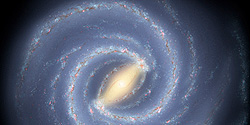New Collaborative Research Centre on the Milky Way
18 November 2010

Picture: NASA/JPL-Caltech/R. Hurt
The origin of the Milky Way and fundamental issues connected with galaxy evolution are the focus of a new Collaborative Research Centre (CRC) at Heidelberg University. It is scheduled to start work at the beginning of next year and will receive a total of approx. 8 million euros from the German Research Foundation (DFG) over four years. CRC 881 “The Milky Way System” is located at Heidelberg University’s Centre for Astronomy (ZAH) and assembles scientists from the Astronomisches Rechen-Institut, the Institute of Theoretical Astrophysics and the Landessternwarte Königstuhl. Non-university research institutions involved are the Max Planck Institute of Astronomy and the Heidelberg Institute for Theoretical Studies (HITS). The coordinator of the collaborative research centre is Prof. Dr. Eva Grebel of the Astronomisches Rechen-Institut.
The research work of CRC 881 revolves around our own galaxy, the Milky Way, a typical spiral galaxy and hence a member of the most common class of massive galaxies in the universe. The scientists involved in the new collaborative research centre will investigate the origins and evolution of the Milky Way in order to clarify fundamental principles of galaxy formation. “Due to our location in the Milky Way, our Galaxy is a unique laboratory for the detailed exploration of the physical processes determining galaxy evolution,” says Prof. Grebel. “The Milky Way system is the only place where we can engage in ‘galactic archaeology’ and use the stars as fossil indicators of chemical evolution and the cosmic matter cycle.” Other aims of the research work done by CRC 881 are to test the predictions of cosmological models on galaxy formation and to investigate the small-scale distribution of dark matter.
New and highly sensitive sky surveys, notably the European satellite mission Gaia, and progress in theoretical modelling have ushered in a new era in research on the Milky Way, says Prof. Grebel, going on to emphasise that Heidelberg’s astronomers are in an excellent position to make a crucial contribution. She points to the foundation of the Centre for Astronomy with six strategically oriented new professorships in theoretical and observational astronomy and the key role played by Heidelberg scientists in the essential large-scale international projects. “With the broad research strategy of our collaborative research centre we can make an essential contribution to understanding how our home galaxy came about and how it functions,” she adds. “Accordingly, we will also be able to answer many fundamental questions about galaxy formation and evolution.” In addition, the Haus der Astronomie provides excellent opportunities for making research on the Milky Way accessible to the general public.
For more information, go to www.zah.uni-heidelberg.de .
Note for news desks
Digital picture material is available from the Press Office.
Contact
Dr. Guido Thimm
Centre for Astronomy
phone: +49 6221 541805
thimm@ari.uni-heidelberg.de
Communications and Marketing
Press Office, phone: +49 6221 542311
presse@rektorat.uni-heidelberg.de

